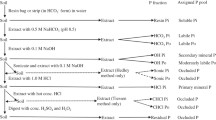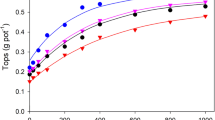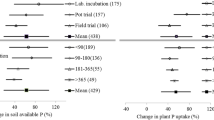Abstract
The pH of the soil in relation to the availability of plant nutrients has been an important research topic in soil fertility and plant nutrition. In the 1930 and 1940 s, a diagram was proposed that showed how the availability of major and minor nutrients was affected by the pH. This conceptual diagram, developed by Emil Truog based on earlier work, included 11 nutrients. The width of the band at any pH value indicated the relative availability of the plant nutrient. The band did not present the actual amount, as that was affected by other factors such as the type of crop, soil and fertilization. For the 11 nutrients on the diagram, a pH of around 6.5 was considered most favorable. The diagram has been often published in text books and soil extension material and continues to be reproduced. This paper reviews how the diagram was developed, and what its limitations are. In recent decades, research in soil fertility and plant nutrition has focused on the biological transformations of plant nutrients in the soil and it has been recognized that the soil pH influences solubility, concentration in soil solution, ionic form, and adsorption and mobility of most plant nutrients. Nutrients interact and different plants respond differently to a change in pH. The soil pH cannot be used to predict or estimate plant nutrient availability, and the diagram should not be used as it suffers from numerous exceptions and barely represents any rules.


Similar content being viewed by others
References
Adcock KG, Gartrell JW, Brennan RF (2001) Calcium deficiency of wheat grown in acidic sandy soil from Southwestern Australia. J Plant Nutr 24(8):1217–1227
Barrow NJ (2017) The effects of pH on phosphate uptake from the soil. Plant Soil 410(1):401–410
Batjes NH (1995) A global dataset of soil pH properties. ISRIC, Wageningen
Blamey FPC (2005) Comments on a figure in “Australian soils and landscapes. An Illustrated Compendium”. ASSSI Newsletter, p 142
Blamey FPC, Chapman J (1982) Soil amelioration effects on peanut growth, yield and quality. Plant Soil 65(3):319–334
Bolt GH (1997) Soil pH, an early diagnostic tool: its determination and interpretation. In: Yaalon DH, Berkowicz S (eds) History of soil science international perspectives. Advances in geoecology. Catena Verlag, Reiskirchen/Germany, pp 177–210
Brady NC, Weil RR (2008) The nature and properties of soils, 14th edn. Pearson-Prentice Hall, Upper Saddle River
Clárk RB (1983) Plant genotype differences in the uptake, translocation, accumulation, and use of mineral elements required for plant growth. Plant Soil 72(2–3):175–196
de Geus JG (1973) Fertilizer guide for the tropics and subtropics. Centre d’Etude de l’Azote, Zurich
Dhaliwal SS, Sharma V, Shukla AK (2022) Chapter one - impact of micronutrients in mitigation of abiotic stresses in soils and plants—A progressive step toward crop security and nutritional quality. In: Sparks DL (ed) Advances in Agronomy. Academic, pp 1–78
Dregne HE (1976) Soils of arid regions. Developments in soil science no. 6. Elsevier, Amsterdam
Fernández-Martínez M, Sardans J, Chevallier F, Ciais P, Obersteiner M, Vicca S, Canadell JG, Bastos A, Friedlingstein P, Sitch S, Piao SL, Janssens IA, Peñuelas J (2019) Global trends in carbon sinks and their relationships with CO2 and temperature. Nat Clim Change 9(1):73–79
Fine AK, van Es H, Schindelbeck R (2017) Statistics, scoring functions, and regional analysis of a comprehensive soil health database. Soil Sci Soc Am J 81:589–601
Foy CD, Oakes AJ, Schwartz JW (1979) Adaptation of some introduced eragrostis species to calcareous soil and acid mine spoil. Commun Soil Sci Plant Anal 10(6):953–968
Hartemink AE (1998) Acidification and pH buffering capacity of alluvial soils under sugarcane. Exp Agric 34(2):231–243
Hartemink AE (2021) Soil Science Americana - chronicles and progressions 1860–1960. Springer, Dordrecht
Jackson ML, Attoe OJ (1971) Memoriam Emil Truog 1884–1969. Soil Sci 112:379–380
Kellogg CE (1952) Our garden soils. The MacMIllan Company, New York
Kuppe CW, Kirk GJD, Wissuwa M, Postma JA (2022) Rice increases phosphorus uptake in strongly sorbing soils by intra-root facilitation. Plant Cell Environ 45(3):884–899
Larcher W (2001) Physiological plant ecology. Springer-Verlag, Berlin-Heidelberg
Lenher V, Truog E (1916) The quantitative determination of silica. J Am Chem Soc 38:1050–1063
Marek RS, Richardson JB (2020) Investigating surficial geologic controls on soil properties, inorganic nutrient uptake, and northern hardwood growth in Western Massachusetts, USA. J Soil Sci Plant Nutr 20(3):901–911
McGrath JM, Spargo J, Penn CJ (2014) Soil fertility and plant nutrition. In: van Alfen N (ed) Encyclopedia of Agriculture and Food Systems, vol 5. Elsevier, San Diego, pp 166–184
Moody PW, Aitken RL, Dickson T (1998) Field amelioration of acidic soils in south-east Queensland. III. Relationships of maize yield response to lime and unamended soil properties. Aust J Agric Res 49(4):649–656
Penn CJ, Camberato JJ (2019) A critical review on soil chemical processes that control how Soil pH affects phosphorus availability to plants. Agriculture 9(6):120
Pettinger NA (1936) A useful chart for teaching the relation of soil reaction to the availability of plant nutrients to crops. Virginia Agricultural and Mechanical College and Polytechnic Institute and the United States Department of Agriculture, Cooperating, Blacksburg
Rashid A, Rafique E, Bughio N (1997) Micronutrient deficiencies in rainfed calcareous soils of pakistan. III. Boron nutrition of sorghum. Commun Soil Sci Plant Anal 28(6–8):441–454
Russell JS, Chapman AL (1988) Sulfur deficiency in rice grown on the alkaline soils of the ord irrigation area, western australia. Aust J Exp Agric 28(1):111–117
Sanchez PA, Salinas JG (1981) Low-input technology for managing oxisols and ultisols in tropical America. Adv Agron 34:279–406
Simonson RW (1995) Airborne dust and its significance to soils. Geoderma 65(1–2):1–43
Slessarev EW, Lin Y, Bingham NL, Johnson JE, Dai Y, Schimel JP, Chadwick OA (2016) Water balance creates a threshold in soil pH at the global scale. Nature 540(7634):567–569
Sparks DL (2003) Environmental soil chemistry, 2nd edn. Academic, Amsterdam
Sposito G (1989) The chemistry of soils. Oxford University Press, New York
Truog E (1915) Soil acidity and methods for its detection. Science 42:505–507
Truog E (1918) Soil acidity: I. Relation to growth of plants. Soil Science V:169–195
Truog E (1920) Testing soils for acidity. Bulletin. Agricultural Experiment Station, University of Wisconsin, Madison, p 24
Truog E (1937a) Availability of essential soil elements - a relative matter. Soil Sci Soc Am Proc (1):135–142
Truog E (1937b) A new soil acidity test for field purposes. Soil Sci Soc Am Proc 1:155–159
Truog E (1946a) Andrew Robeson Whitson 1870–1945. Soil Sci 60:272–274
Truog E (1946b) Soil reaction influence on availability of plant nutrients. Soil Sci Soc Am Proc 11:305–308
Truog E (1965) Reflections of a professor of soil science. Soil Sci 99:143–146
Truog E, Attoe O, Jackson M (1945) Fertilizer application rationalized. Soil Sci Soc Am Proc 10:219–223
Vega S, Calisay M, Hue NV (1992) Manganese toxicity in cowpea as affected by soil pH and sewage sludge amendments. J Plant Nutr 15(2):219–231
von Uexküll HR, Mutert E (1995) Global extent, development and economic impact of acid soils. Plant Soil 171(1):1–15
Author information
Authors and Affiliations
Corresponding author
Additional information
Responsible Editor: Peter J. Gregory.
Publisher’s note
Springer Nature remains neutral with regard to jurisdictional claims in published maps and institutional affiliations.
Rights and permissions
About this article
Cite this article
Hartemink, A.E., Barrow, N.J. Soil pH - nutrient relationships: the diagram. Plant Soil 486, 209–215 (2023). https://doi.org/10.1007/s11104-022-05861-z
Received:
Accepted:
Published:
Issue Date:
DOI: https://doi.org/10.1007/s11104-022-05861-z




